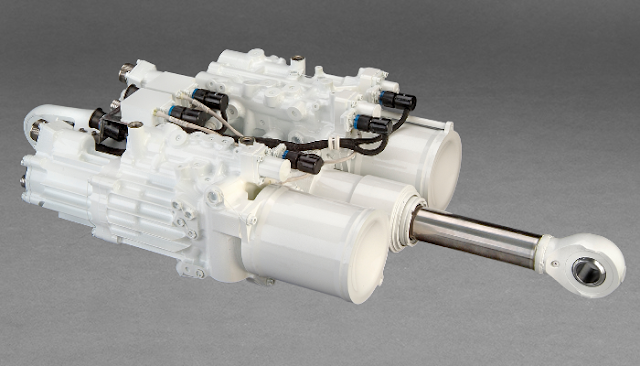Aircraft Actuators: The Unsung Heroes That Make Flight Possible
 |
| Aircraft Actuators |
Aircraft require various mechanical systems and components
to function properly and safely. While many of these systems operate behind the
scenes, they play a critical role in flight. One such component that is
integral to aircraft operation but often goes unnoticed are actuators.
Actuators are electromechanical devices that help convert electrical or
hydraulic signals into physical movement. On aircraft, they are utilized
throughout to move flight control surfaces, landing gear, and other mechanisms
that are essential for take-off, landing, and safe flight.
Types of Actuators Used on Aircraft
There are a few main types of actuators commonly found on modern aircraft:
Hydraulic Actuators: Hydraulic actuators are among the most prevalent actuator
types used on commercial and military aircraft. They utilize hydraulic
pressures to generate movement which allows for strong, precise movements of
heavy components. Hydraulic actuators are frequently employed to control flight
surfaces like ailerons, elevators, and rudders. Their reliability and power
capabilities make them well-suited for critical flight control functions.
Electromechanical Actuators: Also known as electric Actuators, electromechanical actuators
generate movement through electric motors rather than hydraulics. They are
generally lighter and require less maintenance than hydraulic actuators. Common
applications include moving high-lift devices, landing gear, and other
secondary flight control systems. Some newer aircraft are utilizing
electromechanical actuators more extensively as electric flight increasingly
takes hold.
Pneumatic Actuators: While less common than hydraulic or electromechanical
types, some aircraft still use pneumatic actuators which are driven by
compressed air. Applications may include operating cargo doors or auxiliary
flight control surfaces. Pneumatic actuators tend to be simpler and lighter
than hydraulic equivalents.
Rod End Actuators: Also called push-pull actuators, rod end actuators function
through mechanical linkages rather than hydraulic/electric power. They are
generally found on small aircraft, ultralights, and homebuilts to operate
flight controls in a basic manner.
Key Functions of Actuators in Aircraft Operation
Now that we understand the different actuator types, we will explore some of
their most critical functions that enable safe aircraft operation:
Flight Control: As mentioned, hydraulic actuators almost universally power
primary flight control surfaces like ailerons, elevators, rudders, and flaps.
They provide the precise, forceful movements needed to direct the aircraft
during all phases of flight.
Landing Gear Operation: Actuators hydraulically or electrically retract and
extend aircraft landing gear. This includes everything from simple strut gear
to complex tricycle systems. Proper landing gear operation is vital for
takeoffs and landings.
High Lift Device Control: High lift devices such as slats and flaps are
actuated to optimize wing lift during takeoff and landing via approach
maneuvers. Actuators position these flight surfaces for each phase of flight.
Weapon Bay Doors: Military aircraft often rely on actuators to rapidly open and
close internal weapon bay doors to deploy ordnance payloads at the correct
times.
Cargo Door Operation: On commercial and military cargo planes, actuators power
internal and external cargo doors to load and unload freight.
Auxiliary Functions: Additional uses include operating shades, hatches, probes,
antennas, and other movable components as needed.
Significant Role in Aircraft Safety
As the above functions demonstrate, actuators are integral to practically every
major system involved in getting aircraft airborne and back on the ground again
in one piece. Their reliable, precise operation is absolutely critical for
safety. Any actuator failure could potentially lead to disastrous control issues,
inability to takeoff or land, cargo/payload instability, and more. Therefore,
actuators are designed with redundancies, undergo rigorous testing, and require
frequent maintenance inspections. While generally operating out of sight,
actuators undeniably play an important unsung role in the dependable operation
of all aircraft types. With new technologies advancing actuator capabilities
further, their contributions to aviation safety will surely continue.
For More Details On The Report, Read: https://www.trendingwebwire.com/aircraft-actuators-the-unsung-heroes-behind-aircraft-control/

.jpg)

Comments
Post a Comment